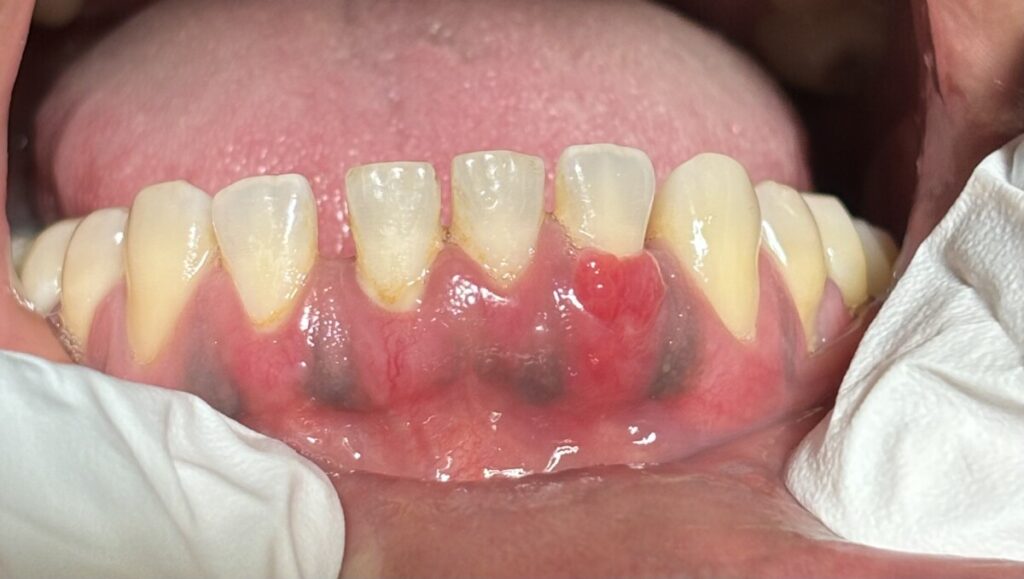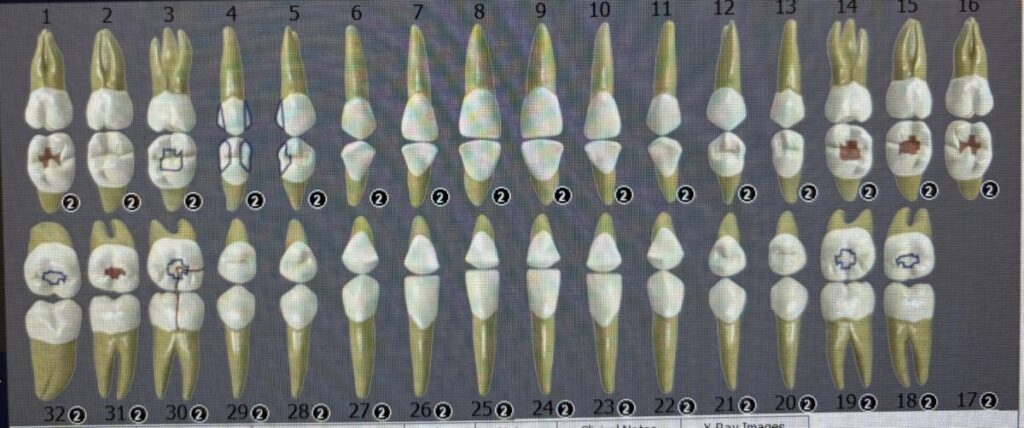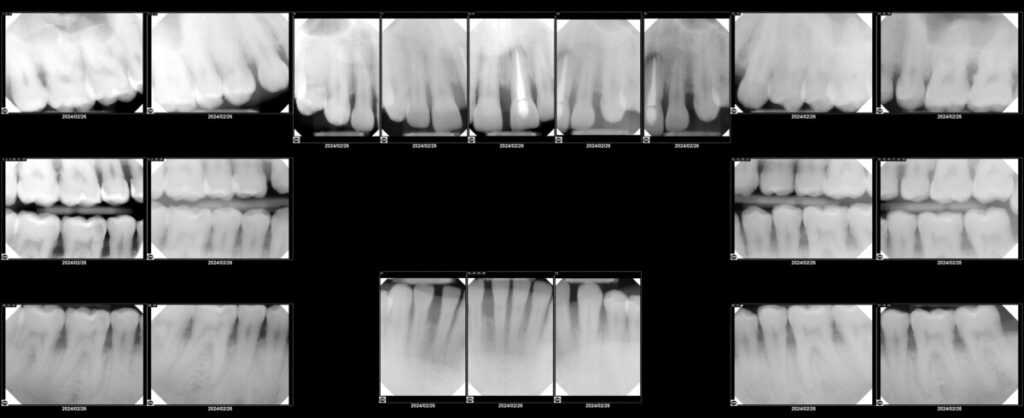This case study focuses on a 41-year-old African-Latino Male patient with several dental concerns, including pyogenic granuloma lesions, cavities, and periodontitis. The patient’s chief complaint is that his teeth bleed when brushing, he has bad breath and a dry mouth, and his teeth are sensitive to cold drinks. The last physical exam was in 2014, more than ten years ago. The patient stated that he is not allergic to medication and has no systemic condition. The patient has not been hospitalized in the past five years. BP: 118/88. Pulse: 87, corresponding to hypertension stage I, when blood pressure consistently ranges at 139/89 mm Hg or higher at this stage of high blood pressure, doctors are likely to prescribe a combination of blood pressure medications and lifestyle changes. The ASA is III due to uncontrolled hypertension and smoking. Not controlled high blood pressure. The patient’s last visit to his primary doctor was over ten years ago; this patient does not report any medical condition but might be encountering blood pressure problems. The patient reports no symptoms; however, high blood pressure often has no symptoms. Over time, if untreated, it can cause health conditions such as heart disease and stroke. The patient drinks a glass of wine and smokes Marijuana every weekend. The patient’s last dental exam was ten years ago, and x-rays were taken. The patient does not remember how many. The patient brushes his teeth twice daily using a manual toothbrush with an up-and-down motion and Colgate toothpaste. The patient stated that he flosses sometimes but does not use a mouth rinse.
Summary of Clinical Findings
Extraoral/Intraoral Findings: There is a 2X2 papule below the right eye, which is asymptomatic. The patient states he will see the dermatologist. There is a 10X8 Pyogenic Granuloma on the gingiva margin on tooth #23, red in color, regular shape, and asymptomatic. Pyogenic granuloma is a tumor-like growth of the oral cavity, frequently located surrounding the anterior teeth or skin, and is considered neoplastic. Traditionally, the treatment of choice for this type of lesion is full surgical excision with sub-periosteal curettage. An oral pathology consultation and hygiene instruction were administered, followed by root scaling and planning.

Dental charting: Bilateral class I by molar and open bite. Overjet 0mm and overbite 0%. The existing restoration is charted as seen. Tooth #17 is not clinically present. Periodontal Assessment: Generalized red, soft, and inflamed gingival. Localized rolled papilla on anterior lower teeth and enlarged on posterior teeth. Generalized BOP. Gingival margin is apical to the CEJ. Calculus: Generalized heavy supragingival and subgingival calculus. Moderate stains on lingual surfaces of upper and lower anterior teeth.

Periodontal charting: Probing depth ranges between 5-7mm on posterior teeth and 3- 5mm on anterior teeth. Gingival recession ranging between 1 and 2mm on posterior teeth. Mobility class I is present on #8,#9, and #23-26. Composite restorations on tooth # 3-O, #4MD #5-D, # 19-OB, #18-O, #19 -O, #30-O and fracture tooth, #31-O. Caries lesions on #2-O, #14-O, #15-O, #16-O, #31-0 and #32-O.

Radiographic statement: FMS exposed on 7mA and 70kV. No carious lesion noted. Generalized subgingival calculus. Generalized 30% of bone loss on posterior teeth with localized 50% of horizontal bone loss on the anterior teeth. Periapical radiolucency on tooth #9. All findings were discussed with the patient.

Dental Hygiene Diagnosis
Periodontal Diagnosis: Periodontitis Stage III Grade C based on multiple factors: Generalized moderate bleeding on probing and exploring. Generalized up to 30% radiographic bone loss, with up to 50% localized bone loss on anterior teeth. Generalized inflammation on all quadrants. Probing depth on posterior teeth readings of 5-7mm. Generalized heavy subgingival calculus on all quadrants. Heavy supragingival calculus generalized.
Risk for Caries: High based on CAMBRA assessment. The patient is at high risk because the patient presents with active caries. Patient often feels dry mouth, the cause of this may be because of the recreational drug use of marijuana.
Dental Hygiene Care Plan
Educate the patient about the consequences of Marijuana smoking and advise that it may be the reason for the dry mouth and periodontal disease.
- PI/OHI: I introduced the bass brushing techniques and the c-shape flossing method. I recommended the use of fluoride-sensitive toothpaste and Peroxyl Colgate Mouthrinse. I explained the benefits and importance of brushing at night and flossing. I discussed diet with the patient and explained the consequences of a non-healthy diet.
- Two visits were used for scaling and root planing using ultrasonic and hand scaling. Oraqix (2.5% lidocaine and 2.5% prilocaine) and local anesthesia were used for pain management. The patient was comfortable during the procedure. 5% NaF Varnish fluoride was applied, and post-op instructions were given—warm salted water was recommended for gum soreness.
- Referral to a Dentist for caries lesions and periodontal evaluation was given.
- Referral to a physician for a complete check-up and blood pressure evaluation.
Challenges during treatment
Treating a patient with high blood pressure, recreational marijuana use, and periodontitis with heavy calculus deposits can be a challenging task for any healthcare professional. High blood pressure and recreational marijuana use can potentially affect the patient’s response to medications and can be the reason for xerostomia, causing caries and more plaque accumulation. In addition, periodontitis with heavy calculus deposits may require extensive treatment, which can be uncomfortable for the patient and require multiple visits. It is important to thoroughly assess the patient’s medical history and communicate with their primary care physician to ensure safe and effective treatment. Proper pain management and anxiety control measures should be taken to ensure patient comfort throughout the treatment process. Frequent follow-up appointments and consistent oral hygiene habits can also play a crucial role in the success of the treatment.
Evaluation of Care
The prognosis for a patient with high blood pressure, marijuana use, and periodontitis with heavy calculus deposits can vary depending on various factors, such as the severity of the condition, the effectiveness of treatment, and the patient’s overall health. One of the most important factors is the control of high blood pressure. If the patient’s blood pressure is consistently managed and brought to a safe range through lifestyle modifications and medication, it can significantly reduce the risk of cardiovascular complications. Another factor to evaluate is the control of marijuana use. If the patient can quit or reduce their recreational marijuana consumption, it can reduce the risk of complications during dental procedures and improve their overall health. Finally, the patient outcome was positive, with the proper care and management, improved oral health care, and reduced risk of complications associated with these conditions.


